Our New Report Tracks the Value of Native Forest Restoration

Forest restoration is unique among proposed carbon capture solutions in that it’s both a regenerative investment, in which the total value grows over time, and a widely accessible one.
Today, we’re releasing a new report, co-authored with Frontier Economics, that examines the societal and monetary value of scaling reforestation projects all over the world.
Restoration is a regenerative investment opportunity
The recent growth of carbon markets, clean energy technology, and a renewed global focus on restoring degraded land has created an opportunity to scale restoration initiatives, benefitting landowners, local communities, and the climate.
Unlike many other proposed carbon capture solutions, money spent on land restoration is not just consumed — it’s an investment that pays off for decades in material terms. Forests provide a huge array of products and services: food, medicine, building materials, fiber, recreational space, water filtration, and carbon sequestration, to name just a few. The conversion of degraded land into thriving and productive ecosystems represents a global real estate opportunity, and the ongoing rise of carbon prices makes these projects an even more attractive investment.
Based on conservative carbon price projections, this report estimated that the net present value of potential new revenue streams from restoring all degraded tropical and temperate forest ecosystems globally could be an estimated US$1 trillion.
Restoration provides local and global benefits
Any individual, organization, or government with access to degraded land has the opportunity to invest in carbon capture and sequestration via forest restoration.
In addition, engaging local stakeholders and ensuring they have financial incentives to maintain and care for a forest is critical to a project’s long-term success. The most sustainable projects benefit all people involved, including landowners and nearby communities.
At Terraformation, we’re working with a growing partner network across five continents to restore degraded land to its original native forest ecosystems. We know that our goal of restoring billions of acres of marginal land is ambitious. It will require an enormous coordinated effort at a massive scale, which is why we’re empowering local forest restoration teams with tools, training, financing, and other support to address the biggest bottlenecks to restoration projects head-on.
I hope you’ll read the new report and join Terraformation in our mission of solving climate change.







.webp)
.webp)







